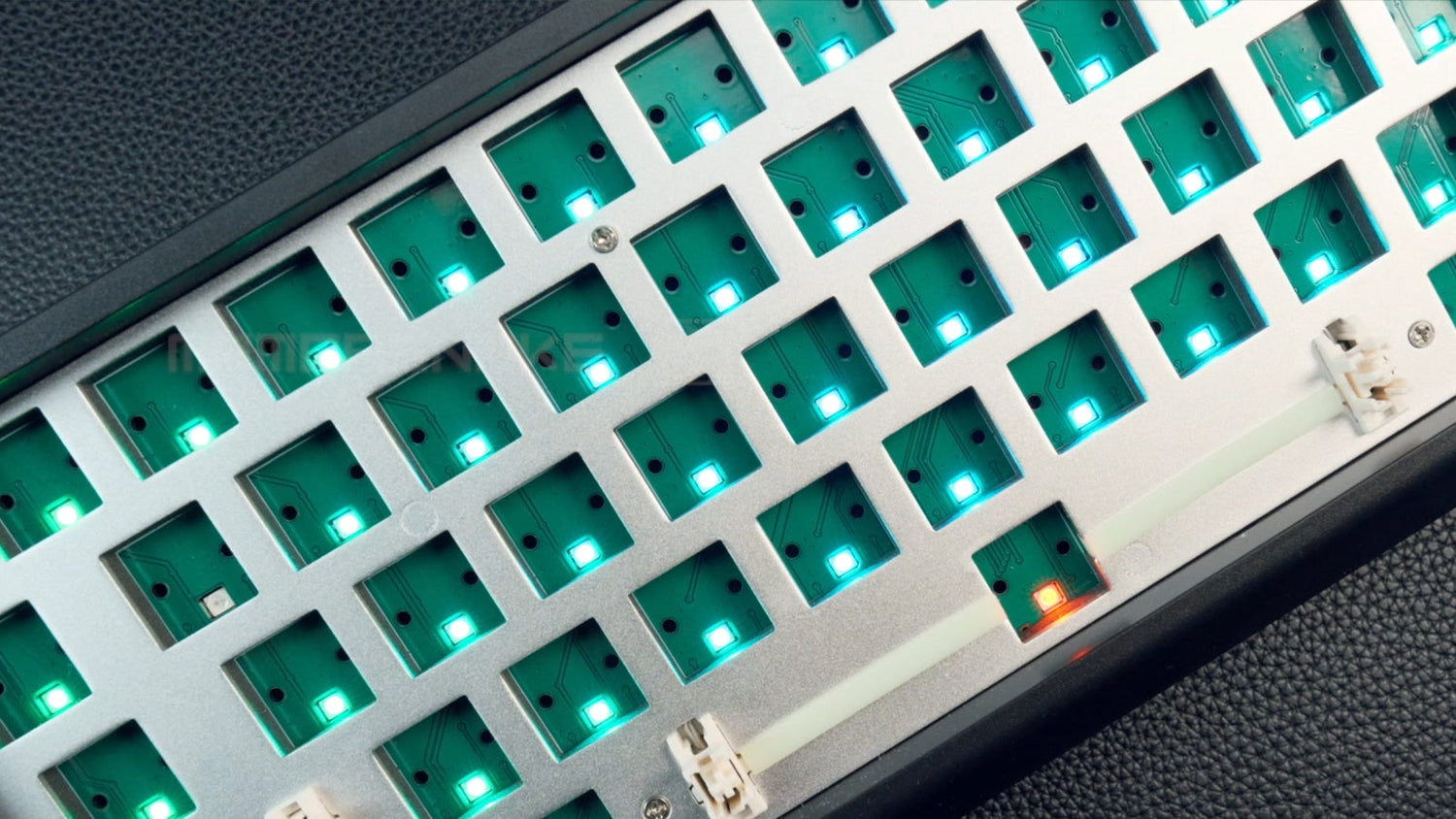キーボードを徹底的に掃除したい場合、新しいキーキャップセットを取り付けたい場合、様々なスイッチを試したい場合、あるいは動作しないキーを修理したい場合、キーキャップとスイッチを正しく取り外す方法を知っておくことは非常に役立ちます。このガイドでは、正しく取り外すための分かりやすい手順をご紹介します。
最も重要なのは、忍耐強く作業すること、適切な工具を使うこと、そして自分のキーボードの種類を理解することです。何よりも、決して無理やり引っ張らないでください。部品が引っかかっているように感じたら、無理に引っ張って何かを壊してしまう前に、作業を中断して何が問題なのかを確認してください。
始める前にやるべきこと
数分かけて準備しておくことで、後々のトラブルを大幅に軽減できます。まずはキーボードの種類を特定しましょう。キーボードの種類によって必要なツールや方法が決まります。
キーボードの知識:ホットスワップ vs. はんだ付け
メカニカルキーボードの主な違いは、スイッチが回路基板にどのように取り付けられているかです。
- ホットスワップキーボード:スイッチを簡単に交換できるように設計されています。ソケットが付いているので、はんだ付けなしでスイッチを取り外し、新しいスイッチを差し込むことができます。カスタマイズに最も使いやすいタイプです。
- はんだ付けキーボード:これらの基板では、各スイッチが回路基板(PCB)に直接はんだ付けされています。取り外すには、はんだを溶かして除去する必要があり、より複雑な作業となります。
自分がどちらのタイプであるかはどうすればわかりますか?
- キーボードの製品ページ、箱、またはマニュアルをご確認ください。メーカーはほとんどの場合、キーボードを「ホットスワップ」または「ホットスワップ可能」と宣伝しています。
- マニュアルで見つからない場合は、お使いのキーボードモデルをオンラインで検索してください。フォーラムのディスカッションや動画レビューでは、ホットスワップ対応ボードかどうかが言及されていることが多いです。
- 上級ユーザーの場合、キーボードを開ければ明確な答えが見つかります。回路基板上のホットスワップソケットは、スイッチピンを差し込む小さなプラスチックまたは金属製のハウジングです。はんだ付けされた基板では、各スイッチの2本の金属ピンが基板から突き出ており、小さなはんだの塊で覆われています。
このガイドでは両方のタイプについて説明していますが、はんだ付けされたスイッチに関するセクションは上級ユーザーのみを対象としていることに注意してください。不適切に行われるとキーボードが損傷するリスクがあるためです。
適切なツールを集める
キーボードのコンポーネントを傷つけたり壊したりしないようにするには、適切なツールを使用することが不可欠です。
すべてのキーキャップの取り外しについて:
ワイヤーキーキャッププーラー:これはおすすめのツールです。安価なプラスチック製のリング型プーラーよりも、キーキャップの側面を傷つける可能性がはるかに低くなります。
ホットスワップスイッチの取り外しの場合:
スイッチプーラー:ピンセットのような小さな工具で、スイッチのリリースタブを押してしっかりと掴み、取り外すことができます。 ホットスワップ対応キーボードには、多くの場合、同梱されています。
[[推荐商品1]]
はんだ付けされたスイッチの取り外し(上級):
- はんだごて:PCB を損傷せずにはんだを溶かすには、温度制御機能付きのはんだごてが必要です。
- はんだ除去ポンプまたはブレード:ポンプ(はんだ吸い取り器)は、吸引力を利用して溶融はんだを除去します。ブレード(はんだ吸い取り線)は、はんだを吸収する銅のメッシュです。
- 煙抽出装置: 作業中はんだの煙を遠ざけるためにこれを強くお勧めします。
オプションだが役立つアイテム:
- キーキャップやネジを整理しておくための小さなトレイまたはボウル。
- 清潔で明るいワークスペース。
- 清掃用のイソプロピルアルコールと綿棒。
キーキャップの取り外し方ガイド
工具が揃ったら、作業を開始できます。以下の手順に従えば、大小を問わずすべてのキーキャップを、何も壊すことなく取り外すことができます。
1. キーボードを準備する
最初のキーを引く前に、いくつかの簡単な手順を実行すると、後で面倒なことが避けられます。
- キーボードのプラグを抜きます。これは、作業中に誤ってキーを押したり、 電気的なショートを起こしたりすることを防ぐための重要な最初のステップです。
- 写真を撮る。スマートフォンでキーボードのレイアウトを上から鮮明に撮影しましょう。この写真は、キーキャップを正しく取り付けるのに非常に役立ちます。特に、各列のキーの形状や高さが異なる場合は、特に役立ちます。

2. 標準キーを削除する
ワイヤーキーキャッププーラーをキーキャップにかぶせ、文字や数字を含む通常サイズのキーの2つの対角コーナーの下にワイヤーを滑り込ませます。しっかりと固定されたら、キーキャップを慎重に揺すり、まっすぐ上に引き抜き、キーボードから離します。斜めに引くと、下にあるスイッチステムに張力がかかり、破損する可能性があるため、注意してください。
3. 大きくて安定したキーを削除する
スタビライザーは、キーの揺れを抑えるワイヤーで、スペースキーやEnterキーなどの大きなキーに使用されています。スタビライザーを取り外すには、工具を使ってゆっくりと引き上げ、下にあるワイヤーが見えるようにしてください。キーキャップを完全に剥がす前に、小さなプラスチッククリップからワイヤーを慎重に外す必要があります。キーキャップを強く引っ張ると、壊れやすいスタビライザーが壊れてしまう可能性があるので、焦らずに作業を進めてください。
スイッチの取り外し方法
キーキャップを外すと、スイッチにアクセスできます。パート1で説明したように、方法はキーボードの種類によって異なります。
1. ホットスワップスイッチを取り外す
これはより簡単な方法です。まず、スイッチハウジングの上下(北側と南側)にある2つの小さなプラスチック製のタブを見つけます。 スイッチプラーの突起が両方のタブを内側に押し込むように位置を合わせます。プラーをしっかりと握ってスイッチをトッププレートから外し、まっすぐ上に引き上げながら軽く揺らします。
スイッチを引き抜く際は、底部の2本の繊細な金属ピンが曲がりやすいので注意してください。強い抵抗を感じたら、引っ張るのをやめてください。ピンが引っかかったり曲がったりしている可能性があります。スイッチをまっすぐにして、もう一度優しく引いてください。
2. はんだ付けされたスイッチを取り外す(上級)
警告:この作業は、正しく行わないとキーボードの回路基板(PCB)に永久的な損傷を与える危険性が高くなります。はんだ付けの経験がない場合は、キーボードで作業する前に、古い電子機器や壊れた電子機器で練習することを強くお勧めします。
まず、スイッチがはんだ付けされている PCB の背面にアクセスできるように、キーボードのケースを分解する必要があります。
- はんだごてを使用して、スイッチの 2 つのはんだ接合部のうちの 1 つを、はんだが溶けて光沢が出るまで加熱します。
- 液体のはんだを素早く除去します。はんだ吸い取りポンプ(はんだ吸い取り器)を使用するか、はんだ吸い取り線(銅製の吸取線)をはんだごてで接合部に押し当てて吸収させる方法もあります。
- 同じスイッチの 2 番目のピンに対してまったく同じプロセスを繰り返します。
- 両方のピンのはんだ付けがなくなると、スイッチは緩みます。キーボードの上部からスイッチをゆっくりと押し出すことができるはずです。

検査、清掃、再設置
スイッチを取り外したらすぐに、 キーボードを掃除して部品を確認するのが最適です。ここで数分かけて準備しておけば、すべて簡単に元に戻り、正常に動作するようになります。
検査と清掃
部品を組み立てる前に、必ず点検してください。各スイッチの2本の金属ピンを確認してください。片方が少し曲がっている場合は、ピンセットを使って慎重にまっすぐに伸ばしてください。片方がひどく折れ曲がっている場合は、そのスイッチは使用しないでください。その後、ブラシまたはエアダスターを使ってキーボードの天板を清掃します。頑固な汚れがある場合は、少量のイソプロピルアルコールを含ませた綿棒を使用してください。作業を進める前に、すべてが完全に乾いていることを確認してください。
ホットスワップスイッチの再インストール
ホットスワップスイッチを元に戻す前に、2本の金属ピンが正確にまっすぐになっていることを確認してください。ピンをキーボードのソケットの穴に差し込み、一方向にしか入らないようにしてください。次に、カチッという音がするまでスイッチをまっすぐ押し下げます。カチッという音がすれば、しっかりと固定されます。回路基板が曲がらないように、もう片方の手でスイッチの後ろを支えると効果的です。スイッチを差し込んだら、すぐに平らで緩んでいないか確認してください。
キーキャップの再インストール
先ほど撮影した写真を参考に、キーキャップを元に戻した際に正しい位置に戻っているか確認してください。キーキャップ下部のステムを強く押し下げ、スイッチのステムと一直線になるようにしてください。スペースバーやShiftキーなどの大きなキーを押す際は、キーキャップがスタビライザーポストと一直線になっていることを確認してください。

最終チェックを行ってください。
すべてを組み立てたら、キーボードを接続します。テキストドキュメントを開くか、無料のオンラインキーボードテスターを使って、操作したすべてのキーを一つずつチェックしてください。キーが反応しない場合、最も一般的な原因は、スイッチのピンの1つが再取り付け中に曲がってしまい、ホットスワップソケットに差し込まれていないことです。この場合、キーボードのプラグを抜き、ピンの配置に細心の注意を払いながら、そのスイッチを再取り付けしてください。忍耐強く、計画的に作業することで、自信を持って自分だけのキーボードをカスタマイズし、メンテナンスすることができます。



